- The Overlanding Crowd
- Posts
- ARB 4x4 Accessories (1975), deep-dive into the company history
ARB 4x4 Accessories (1975), deep-dive into the company history
Plus Overlanding trends, and what is Meshtastic?
Hi, Overlanding Crowd.
And welcome to our very first Newsletter!
As a quick reminder, this is a free weekly B2B newsletter which will delve into the companies in the space via a weekly deep-dive, as well as trends, tactics and innovation in our specific niche. And the niche we focus on encompasses Overlanding, Van-Life and Vehicle Based Camping.
This week, in Chapter 1, we look at:
Recent (May) top 5 overlanding discussion topics as researched by our AI social scraping tool
Mesh Networks - leveraging off Meshtastic in particular - a viable option?
Deep-dive into ARB 4x4 Accessories - A legend in the industry
PS - if you’re new here or have been forwarded this email, you can sign up for the free newsletter here:
And please share if you like what we do. It helps enormously to drive down our cost or reader acquisition.
“A ship is safe in harbor, but that’s not what ships are built for.” - John A. Shedd
Top 5 Overlanding Trends (Week Ending May 24, 2025)
1. [Rooftop Tents] – Mounting Failures on Heavier Rigs
📍 Platform: Reddit (r/Overlanding)
🧠 Users report recurring issues with tent mounts failing on 3/4-ton trucks with bed racks. Heavier builds seem to stress mounts not rated for long-distance vibration.
2. [EV Overlanding] – Battery Drain from Fridge + Solar Use
📍 Platform: YouTube (comments on Rivian R1T build video)
🧠 Commenters are debating whether the dual-zone fridge setups are worth the battery hit, especially in cloudy conditions. Several mention falling back to ice chests.
3. [Suspension Tuning] – Air vs. Coil for Long-Term Touring
📍 Platform: Forum (Expedition Portal)
🧠 Heated discussion about whether air suspension setups are worth the complexity for overland rigs doing 10,000+ mile tours. Mechanical coils still favored for serviceability.
4. [Battery Systems] – DIY Lithium Kits Catching On
📍 Platform: Reddit (r/4x4)
🧠 A DIY lithium kit using server rack batteries is gaining traction. Post includes step-by-step and BOM. Strong interest from van-lifers and overlanders wanting $1,000+ savings.
5. [Aftermarket Lighting] – Complaints Around Glare + Beam Spread
📍 Platform: YouTube (product comparison review)
🧠 Users call out popular brands for excessive glare and poor lateral coverage. Multiple comments suggest that “brighter isn’t always better,” especially in wooded trail driving.
What’s a Mesh Network—and Why SOME Off-Roaders Love Meshtastic
Imagine being able to message your buddies miles away—no cell service, no Wi-Fi, just radios chatting with each other. That’s the idea behind a mesh network. Instead of relying on a single tower or hotspot, each device connects with nearby ones, passing messages along until they reach their destination. It’s like a digital game of telephone, but way more reliable.
Enter Meshtastic—an open-source project that brings this idea to life using LoRa radios (that’s “Long Range”). These tiny, low-power devices can send texts and GPS data over several kilometers, even through trees, hills, or remote trails. Pair one with your phone via Bluetooth, and you’ve got a free, private messaging network that works completely off-grid.
For off-roaders and overlanders, Meshtastic could be a game-changer. Whether you’re crawling through desert canyons or navigating backcountry trails with a group, you can:
Stay in touch with other vehicles even when you're miles apart
Share your GPS location so no one gets lost
Send quick updates (“stuck at the creek”, “heading back to camp”)
Communicate when you’re out of cell range, which—let’s be honest—is half the fun
Some folks mount the devices in their rigs with better antennas for more range, while others just toss one in a backpack for hiking or scouting. The setup is easy, and the community around it is super helpful.
Best of all? No monthly fees, no towers, and no signal anxiety. Just reliable, off-grid communication that keeps your crew connected—no matter how far you roam. And it’s not just me - look at the search trend from Exploding Topics..
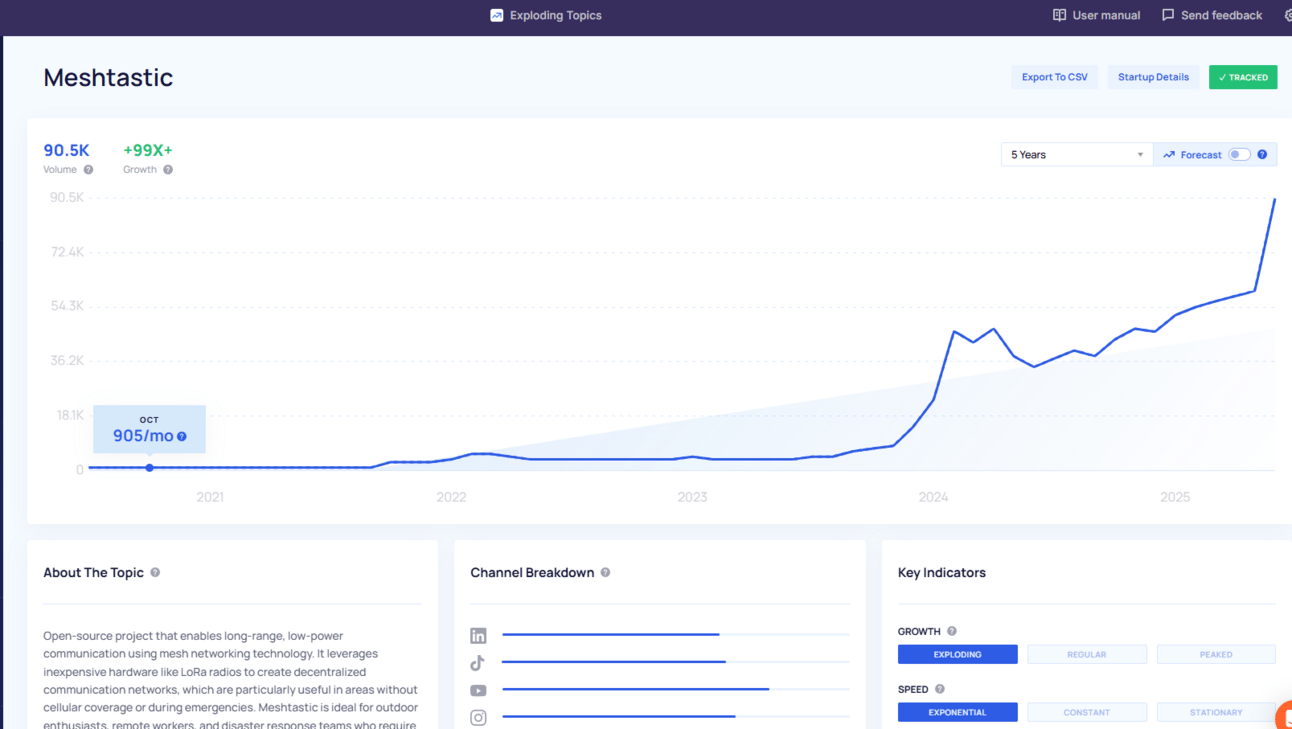
From Backyard to Global Tracks: The ARB Story
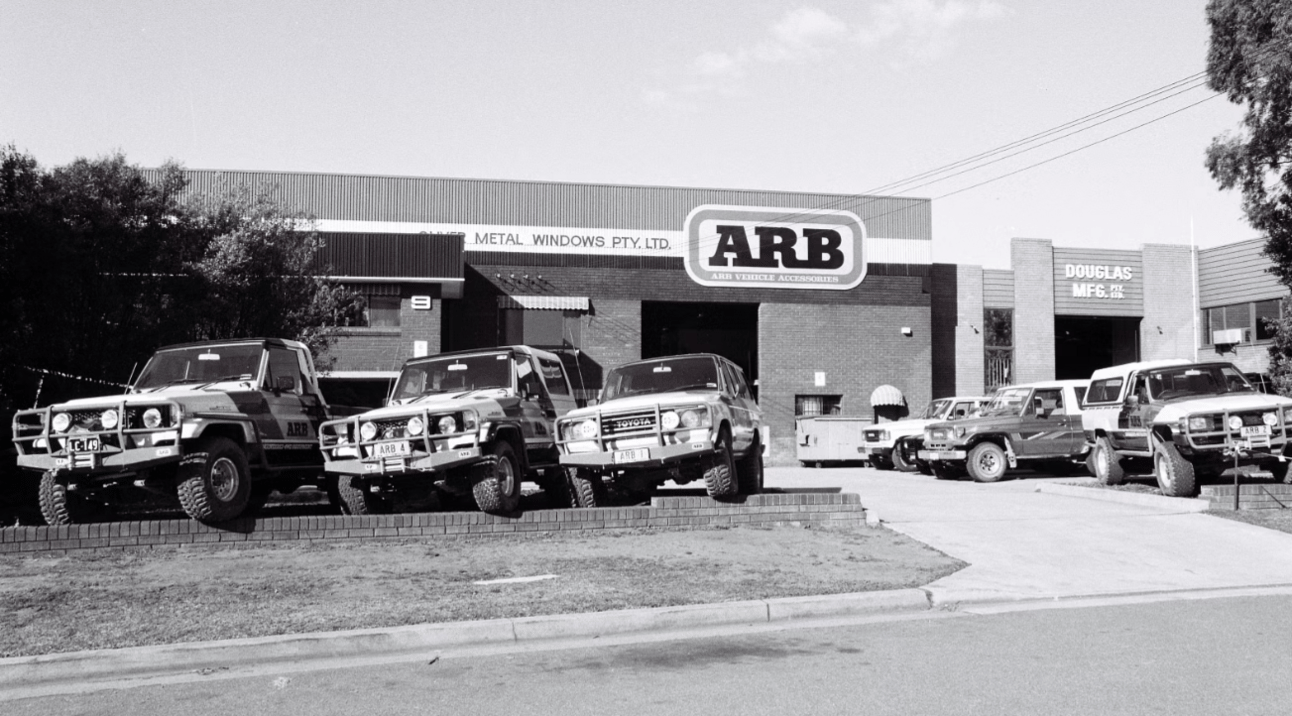
Look, let's just say up front — building a global brand out of a dusty driveway isn't what most folks expect when they hear "world leader in off-road gear." But that’s exactly how ARB started. Honestly, the early story is a bit scrappy. Spelling mistakes on signs, rough welds on racks, and gear that was “good enough” if it didn’t fall off halfway up a washed-out hill.
And yet, here we are. Decades later, ARB 4x4 Accessories is a household name in overlanding. The kind of brand that’s earned its place on rigs from Brisbane to Baja. And it all started with one frustrated man and a Land Rover.
🛠️ Tony Brown’s Big Trip (and Bigger Problem)
The year was 1975. Anthony Ronald Brown — “Tony” to everyone — was bouncing around Cape York in Far North Queensland, Australia. His vehicle was barely holding together. Every bump exposed just how fragile the accessories were: sagging racks, bent bull bars, and suspension kits that felt more ornamental than functional.
Tony was an adventurer, but also a tinkerer. The kind of guy who couldn’t leave bad design alone. When he got back to Melbourne, he didn’t complain. He welded.
In his driveway, with little more than a welder, angle grinder, and a heap of frustration, Tony built what the market didn’t offer — rugged, reliable 4x4 accessories that could actually survive the Outback.
That’s how ARB was born: Anthony Ronald Brown.
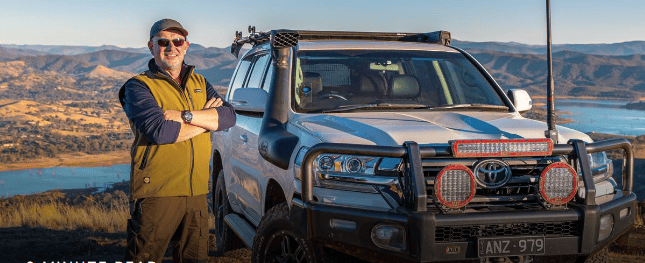
issuu.com
🧱 Laying the Foundation — Literally
From the outset, ARB was a garage project. But word spread. Other drivers saw Tony’s gear and asked for the same.
By the early 1980s, Tony had outgrown the backyard and opened a 1,000 sq ft facility in Ringwood, Victoria. His brothers, Andrew and Roger Brown, joined to help scale production. They weren't investors — they were in the shop, sleeves rolled up.
ARB began to focus on bull bars, roof racks, and suspension components, quickly earning a reputation across Australia. Their mantra: overengineer it, or don’t build it at all.
What started as a hobbyist brand became Australia’s premier 4x4 outfitter — not by advertising, but by being better than everything else out there.
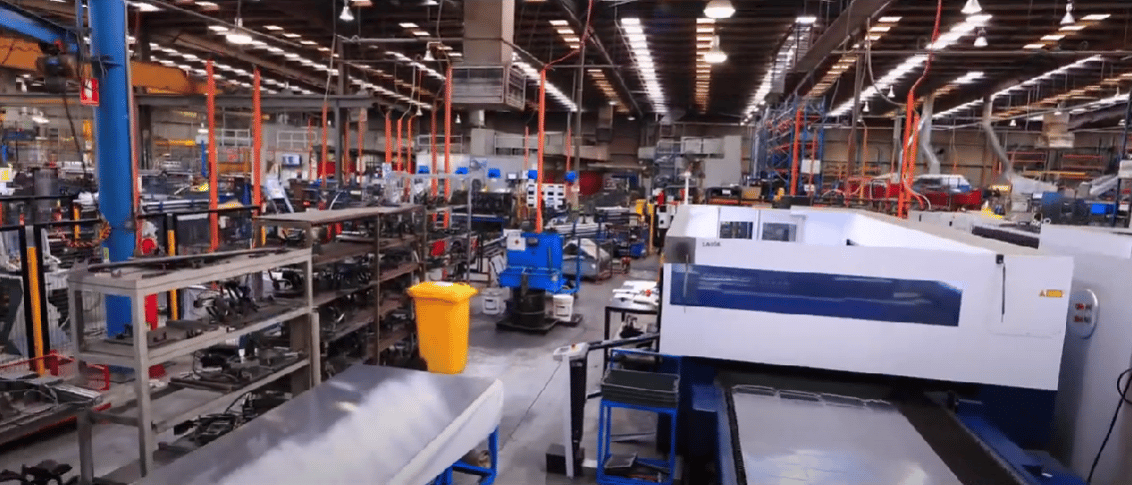
🌎 Going Global — One Bolt at a Time
By the 1990s, ARB wasn’t just Australian anymore. They started shipping gear internationally — first to Europe and Southeast Asia, and eventually the United States.
The company established warehouses and distribution in North America, setting up a base in Seattle and later Texas, to serve the growing appetite for vehicle-based adventure in the U.S. market.
Partnerships followed — especially with Toyota, which began integrating ARB gear into its accessories ecosystem. In fact, Toyota dealerships in some countries sell ARB kits straight from the floor.
ARB gear is now available in over 100 countries, and the brand operates with subsidiaries, dealers, and warehouses on multiple continents.
📈 The Numbers Behind the Metal
Let’s talk numbers — because this isn’t just a rugged brand story, it’s a serious business case.
ARB listed on the Australian Stock Exchange (ASX: ARB) and has seen consistent growth year over year. In 2022, despite global challenges, ARB reported:
Revenue: $693.2 million AUD
Profit after tax: $102.7 million AUD
International sales made up one-third of revenue
And this isn’t a company propped up by trendy fads. Its margins and growth are based on manufacturing, distribution, and strong product loyalty.
They’ve doubled down on in-house design, lean manufacturing, and control of their IP, which allows them to innovate quickly while maintaining quality — a rarity in the gear world.
👔 The Management Shift
For decades, ARB remained a family business at heart. Tony eventually stepped back, and his brothers Andrew and Roger took over. Andrew ran the day-to-day as CEO, and Roger chaired the board.
But in 2022, after over 30 years in control, the Browns passed the torch:
Lachlan McCann, a long-time insider and COO, became CEO
Andrew Fraser, director since 2004, became Chairman
The Browns didn’t vanish — they stayed on in strategic roles. But the move was clear: modernize the business, broaden its leadership, and prep for the next era.
ARB is now a hybrid company — part legacy manufacturer, part high-performance operator. And it's more nimble than ever.
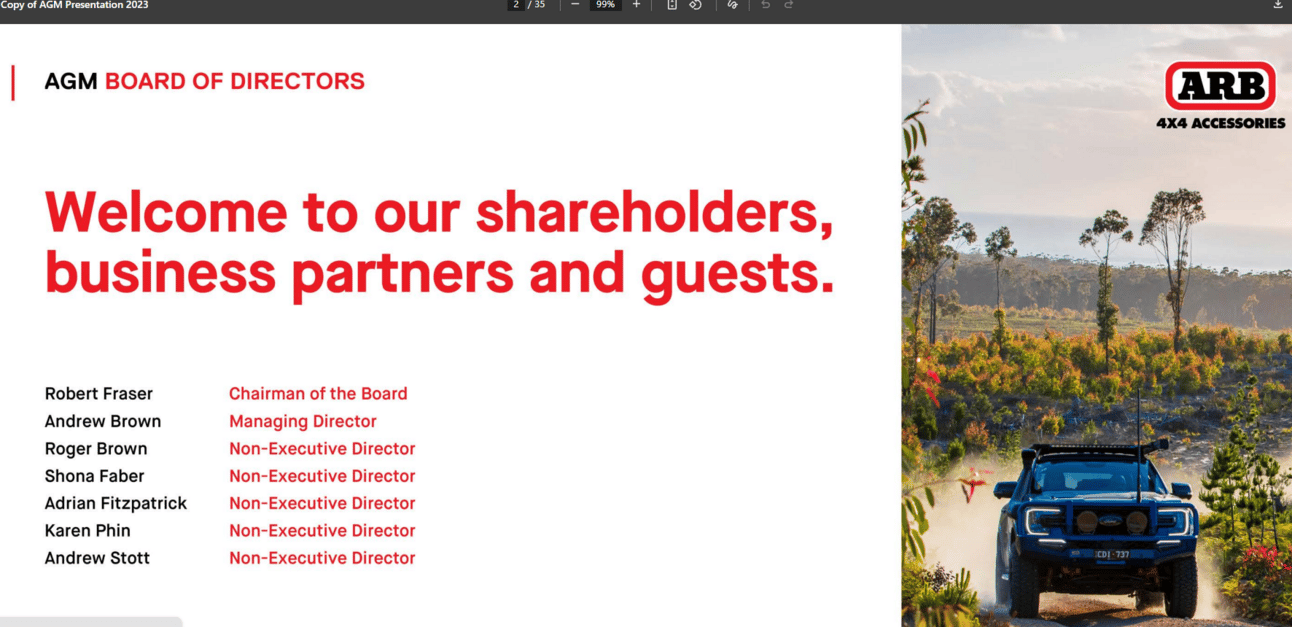
arb.com
🧗 The Bumps in the Road
It hasn’t all been smooth tracks and tidy ledgers.
In 2021–2022, ARB hit international turbulence:
NZ’s “ute tax” impacted sales
US and Asian markets slowed post-COVID
Supply chain delays challenged their just-in-time model
The company saw compression in margin as freight and logistics costs ballooned
And yet, while global performance softened, ARB boomed in Australia, keeping profits solid. They also reacted fast — launching local sourcing strategies, new software for logistics, and ramping up Texas warehousing.
They even made strategic bets on the future: ARB is developing EV-compatible accessories and working with Rivian in the U.S. to ensure their kits adapt to the new world of electrified overlanding.
🧪 Acquisitions and Strategic Moves
ARB has been selective with M&A. Their approach is more about integration than acquisition sprees. But they’ve made moves:
Acquired or partnered with select distributors in Europe and the U.S.
Invested in machining and tooling upgrades for greater autonomy
Collaborated with OEMs to enter the vehicle market at the factory level
Their biggest power play? Vertical integration. ARB controls everything from R&D and manufacturing to distribution and even customer support — a huge reason for their reputation.
🔧 The Gear Philosophy
ARB doesn’t chase trends. It builds what works.
Their bestselling categories:
Bull bars — ARB’s hallmark, crash-tested and globally certified
Old Man Emu suspension kits — tuned for overland comfort + load
Drawer systems — rugged, secure, and modular
Fridge/freezers, compressors, and tents — engineered for actual field use, not Instagram
They also pioneered air lockers, which are now a staple for serious 4x4 enthusiasts and expedition crews.
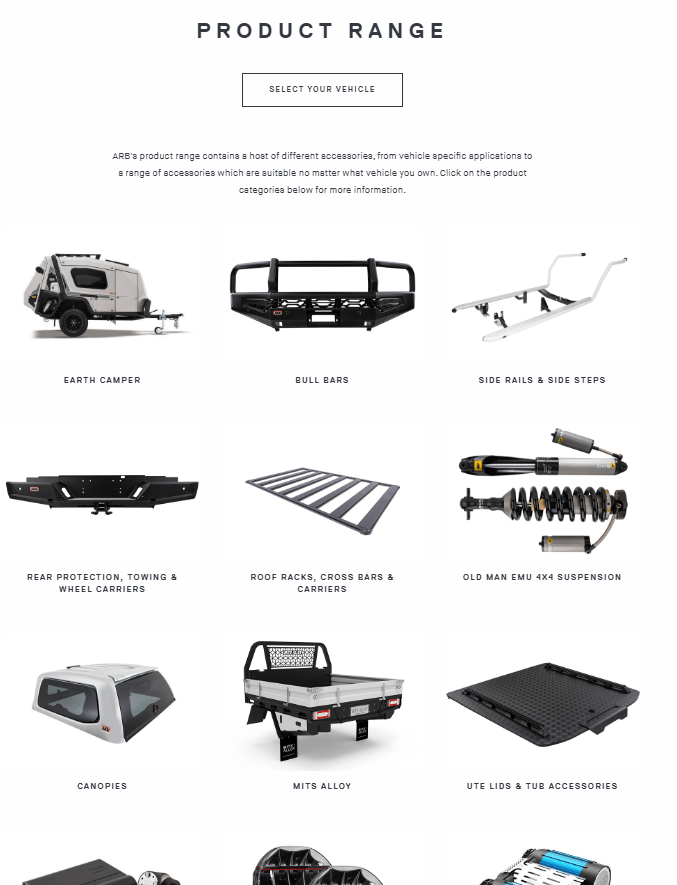
🚀 Where It’s Headed
ARB has its eyes on the future — and they’re not idling.
Key strategic directions:
EV compatibility: battery-safe mounts, lighter materials
Digital platforms: integrated diagnostics and product install tracking
US retail expansion: building direct-to-consumer presence in key off-road states
Tech-driven durability: lighter, stronger, modular builds
More than anything, they want to be first-in-line for global outfitting as overlanding continues to professionalize and expand.
🎯 Why It Matters to the Industry
ARB isn’t just a brand — it’s a blueprint.
It shows what happens when:
A founder understands the problem because they’ve lived it
A business stays obsessively focused on quality
Scaling doesn’t mean abandoning roots
For overlanding brands, ARB proves that you can:
Go global from humble beginnings
Maintain reputation while modernizing
Grow a brand by building better gear — not louder hype
🏁 Final Thoughts
From a Melbourne driveway to a global off-road juggernaut, ARB’s journey is the kind of story that resonates with founders, fabricators, and field-tested operators alike.
It’s not just about steel bumpers and compressors — it’s about a brand that outlasted trends, beat challenges, and built a business with purpose.
For anyone building a company in the overlanding world: this is the bar (no pun intended!)
How was the quality of today's newsletter?Be honest! |
Thanks for reading and I hope you find value in the newsletter. If you do, please share. It helps a lot. Also feel free to reach out directly with any thoughts or feedback (or interests in sponsoring / partnering) at [email protected]
Happy driving.
Until next week, go n-éirí leat!
Derek.
